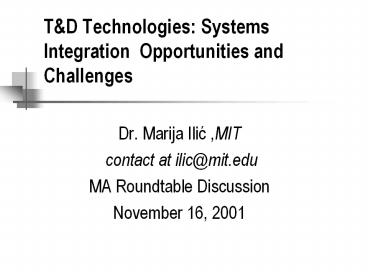T - PowerPoint PPT Presentation
1 / 23
Title:
T
Description:
For implementing energy contracts (value of T to G/D) For maximizing social welfare (by enabling cheapest S ... Example (with Dr Phil Yoon; ytyoon_at_alum.mit.edu) ... – PowerPoint PPT presentation
Number of Views:16
Avg rating:3.0/5.0
Title: T
1
TD Technologies Systems Integration
Opportunities and Challenges
- Dr. Marija Ilic ,MIT
- contact at ilic_at_mit.edu
- MA Roundtable Discussion
- November 16, 2001
2
Topics of discussion
- Technical opportunities and challenges
- Regulatory/pricing opportunities and challenges
- An illustrative example (with Dr. Phil Yoon)
3
Value of transmission service
- For implementing energy contracts (value of T to
G/D) - For maximizing social welfare (by enabling
cheapest S to be delivered to D) - For facilitating Customer Choice (T vs S,
substitutes) level of desired reliability
4
Technical Opportunities
- Build new lines or upgrade/enhance the existing
lines to - -To reduce congestion
- -To deliver more without large transmission
loss - - To help reduce the need for expensive
generation - -To adjust/control delivery on specific paths
- -To implement flow-based contracts
- -To ensure reliability requirements
- New technologies FACTS, HVDC, HVDC-lite,
superconductors, software,control,communications.
5
Technical challenges
- Either over-design not to run into technical
problems - Or, operate closer to the transmission capacity
margin and face more engineering challenges,
such as - -identify best locations/types of TD
technologies to meet given performance at least
cost - -add new technologies to the existing grid
without creating unexpected operating problems
(avoid fighting of different devices) - -avoid maintenance problems due to switching
- -rely on software to estimate and control system
conditions - Long history of these types of problems
6
Technical solutions for system integration
- Careful coordination at different rates
- Real-time measurements and use of these
measurements - Wide-area measurements and communications
- Development of ISO-level software for predicting
the grid conditions in order to coordinate
different components with well understood effect
on system-wide reliability by switching and
controlling right devices at the right time
(weak) - Beat complexity by using DC technologies in
between the control areas even have backbone all
DC and more control closer to the users
7
Possible new technical paradigm
- Very distributed, small scale technologies at all
levels of industry (TD controllable wires,
demand response by various classes of customers
to the price of electricity, transparent benefit
to customers, meaningful mix of various sources
of generationincluding renewable energy) - Law of large numbers, where many small actions
control the system, instead of top down
technologies - Yet minimal coordination needed
8
Financial/regulatory opportunities
- Need an industry environment in which there are
clear signals about the substitutes to the
customer needs (inexpensive generationtransmissio
n is the same as expensive generation) - Markets to nurture evolution of an optimal
grid (capable of making room for equal playing
field for different technologies-suppliers,
customers and/or TD) - Separate effects of new components from the
effects of the existing grid
9
Financial/regulatory obstacles
- Nothing is being built because of the regulatory
uncertainties - TD (and, more generally, technologies) are not
valued for reliability (back-up power value,
value of the wire in case something fails, value
of the interruptible customers) - Misconception that there is no more transmission
capacity and that it would be impossible and
very expensive to increase delivery capacity,
therefore overemphasis on DG (next graph,
courtesy of Tri Gen Co)
10
(No Transcript)
11
Conceptual challenges
- Tariffs to support optimal power system design
(tradeoffs between TD vs Demand technologies vs
Power supply) - Separate TD values from the others, in order to
give clear signal for investment in TD when
appropriate - Give incentives to Transmission Owners to reduce
congestion and to at the same time have
sustainable business based on cheapest solutions
(Case1, vs Case 2) - Avoid slow stakeholders-based approval of TD
investments
12
Conceptual regulatory solutions
- Move from cost regulation for TD to
Performance Based Regulation with clearly defined
transmission product (path provision service) - The transmission owner does not have to justify
to the export area or to the import area
separately (not possible, because of the cost
shift) the job of a TO is to REDUCE CONGESTION
AT THE COMPETITIVE TRANSMISSION PRICE (DIFFERENCE
OF THE EXPECTED LBMPS IN THE TWO AREAS) THE
COMPETITIVE ADVANTAGE IS CHOICE OF TECHNOLOGY
(CASE 1 OVER CASE 2) TO REDUCE COST AT WHICH IT
DELIVERS THE PROMISED PRODUCT. - We propose PBR designs
- For multi-TO/RTO extension, minimal market RTO
be a market for inter-regional transmission
merchant transmission project fit in this design
naturally, and are similar to any other TO within
the RTO
13
Example (with Dr Phil Yoon ytyoon_at_alum.mit.edu)
- Illustrates technical and regualtory
opportunities, challenges and possible solutions
outlined above. - For more details, contact us.
14
(No Transcript)
15
(No Transcript)
16
(No Transcript)
17
(No Transcript)
18
(No Transcript)
19
(No Transcript)
20
(No Transcript)
21
Cost Regulation
- Energy charge nodal price ld_demand
ld_ratio merchandise surplus - Transmission charge ld_ratio trans_cost
Before investment
After investment
EnergyCharge TransCharge EnergyCharge TransCharge
ExportRegion 2.35B 234M 2.32B 255M
ImportRegion 2.79B 266M 2.55B 290M
22
Performance Based Regulation
Energy charge same as cost regulation Transmiss
ion charge nodal price ld_demand flow
charge energy charge
Before investment
After investment
EnergyCharge TransCharge EnergyCharge TransCharge
ExportRegion 2.35B 234M 2.32B 252M
ImportRegion 2.79B 266M 2.55B 292M
23
Summary of Charges
In Millions
In 100,000































